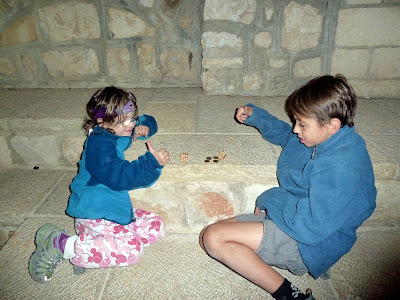There's always more to see in northern Israel. But this is our last post from the North - at least for this trip. In addition to the sights we described in our post of December 4, we had a great time hanging out with friends in Yodfat, soaking up the mountain scenery, visiting old synagogues, wandering through small towns, and eating latkes (potato pancakes) and sufganiyot (donuts) to celebrate Chanukah.
The ancient site of Baram, which is about a kilometer or two from the Lebanese border, contains two synagogues believed to be from the 3rd century CE. The larger synagogue is the main attraction, and its wonderfully preserved facade is a national landmark. A lintel from the smaller synagogue is now housed in the Louvre Museum in Paris. The site also contains the scattered remains of a Maronite Christian village, which was abandoned during the 1948 war. Leaving the site, we drove past a Maronite Christian cemetery and then a Lebanese village just across the border. It looks like a short walk - but you can't get there from here.
 |
| Ruins from the Maronite Christian village |
 |
| More Maronite Christian ruins |
 |
| Maronite Christian cemetery |
 |
| Looking into Lebanon |
 |
| Lebanese village - So close, yet so far |
The village of Peki'in houses another important synagogue, which is depicted on the Israeli 100-shekel note. The current building was constructed in the late 19th century, but it sits on the site of a synagogue from the 3rd-4th centuries CE and it contains two wall tablets that are said to be from the Second Temple in Jerusalem. Jews have lived in Peki'in continuously since Roman times, although only a handful remain today. The majority of the town's residents are of the Druze faith, a monotheistic religious community that emerged in the 11th century as an offshoot from Islam and that is found today primarily in Israel, Jordan, Lebanon and Syria. A substantial minority of the town's population is Muslim, and there are some Christian residents as well. The friendly Druze owner of the restaurant where we ate lunch described his hometown with glowing praise as a model of interfaith harmony. Based on what we've read and heard, this is an exaggeration, but the town is nonetheless a peaceful and inviting place to visit. We wandered through the town's picturesque small streets, toured a house that serves as a Druze museum, enjoyed traditional Druze cuisine (which included a paper thin pita and bulgur wheat with lentils), and of course visited the town's renowned old synagogue.
 |
| Peki'in Synagogue |
 |
| "Downtown" Peki'in |
 |
| Out on the town |
 |
| Druze woman |
 |
| The latest in Druze fashion |
 |
| At the Druze museum |
 |
| More from the Druze museum |
As soon as we got in the car to leave Peki'in, both kids declared: "It's Chanukah and we want sufganiyot!" We promised to find some as we headed toward
Tzfat, a charming hilltop town that serves the center of Jewish mysticism and of klezmer music, and that is home to a number of historic synagogues. We visited Tzfat in August during a particularly hot day, and we vowed to return under cooler circumstances. We arrived just as the sun was setting, and within about two minutes of our arrival in town, we were greeted with a candle lighting ceremony in the middle of the street and we were offered several different kinds of sufganiyot. After the kids consumed two donuts each (it didn't take that long), we bought some dreidels, which differ from American dreidels in that they have a Peh instead of a Shin - to signify that the miracle of Chanukah happened "here," not "there." We wandered through the cobblestone alleys, as people sang Chanukah prayers and lit candles in their windows. We found a quiet, atmospheric spot to sit down and spin our new toys. The kids cheered and groaned, winning and losing their argarot (Israeli cents) with each spin. Both kids said they really enjoyed visiting Tzfat for a second time - who wouldn't like a town where they hand out free donuts immediately on arrival?

 |
| Mmm, donuts! |
During our four days in the North, we squeezed in quite a bit of sightseeing. We also found time to slow down in between touring stops to enjoy the countryside and the marvelous views. Most importantly, though, we spent some time with our friends in Yodfat. The moshav's communal spirit is incredibly uplifting. Doors are unlocked and visitors are always welcome. Children play and wander from one end of the moshav to the other - even at nighttime, safely and independently. There were Chanukah parties and celebrations - with pretty songs and delicious home-made sufganiyot, latkes, lemon-cheese pancakes and some of the best felafel in all of Israel.
It's rare on the road, far from home, where people speak a different language, to feel like you fit in so easily. Yodfat is a special place and the more you visit, the more you want to come back.
 |
| On the road in the North, looking towards Mt. Hermon |
 |
| On the road, not far from Yodfat |
 |
| View from Yodfat of neighboring Arab village |
 |
| On the road again, not far from Yodfat |
 |
| Another pretty view, from just outside Yodfat |
 |
| Giora and Michal rehearsing for the school Chanukah party |
 |
| Mmm, latkes! |
































Hi, i'll be glad to hear from you and discuss some of the published pictures. Please contact me at revitalho@imj.org.il or call to Falk Information Center for Jewish Art & Life +972-26771304. Thank you in advance. With respect. Revital Hovav, Archive officer, Israel Museum Jerusalem
ReplyDelete